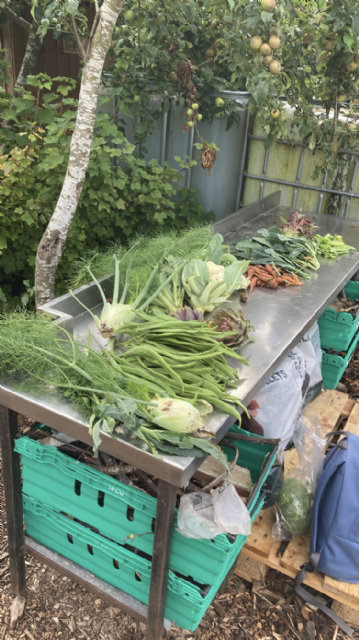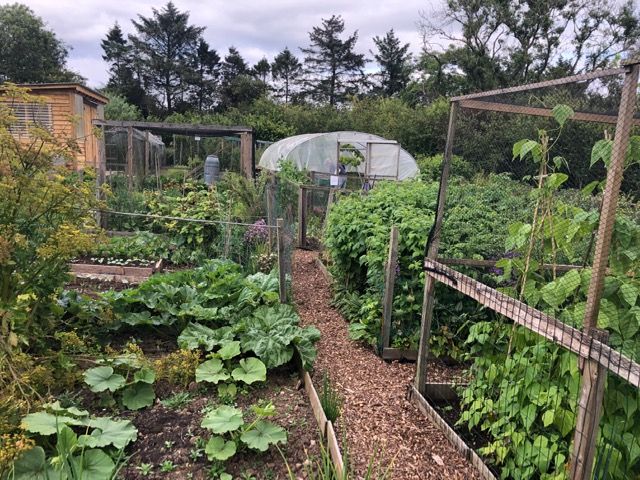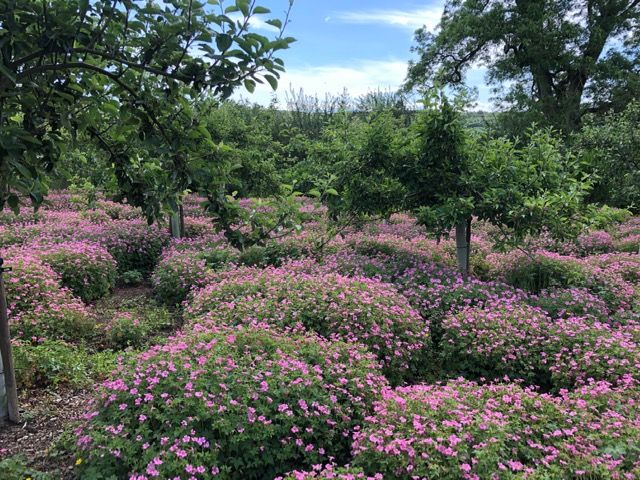Strathkinness Community Garden

A small group of villagers started the garden in 2010 on two acres of land kindly released to us by Gill Edwards. The original purpose of the garden was to turn a wild area into something productive but as the years have passed the garden has developed in a number of surprising and pleasing ways. Probably the most important benefit for the village is that it has become one of several new meeting places where new friendships have been made linking those who have lived in Strathkinness for many years with newcomers. The garden built on a sheltered south facing slope provides a pleasant place to garden, walk or sit and this has been particularly true in 2020 when many from the village have found peace and fresh air during their exercise time in lockdown. |

The garden consists of 30 small individual private allotment plots, a Primary School allotment, the Little Beehive Nursery Garden, and 6 glasshouses each shared by two or more members. Communally there is Iain’s Shed, a machine shed, a soft fruit cage, a polytunnel with a grape vine,a fig and beds producing year round veg, 1 communal glasshouse for plant propagation, communal seating area, rainwater collection, a habitat area for foraging and wildlife, and an Organic no dig fruit and veg garden described in detail later. |

We presently have some 70 people involved individually or communally in the garden and we communicate mainly by WhatsApp or e mail and invite anyone to join in. The Primary School have regular after school gardening sessions and the Little Beehive Nursery visit their own garden several times a week. 6 young people have gained Duke of Edinburgh’s award through the garden. The Village Beaver and Cub packs have helped maintain the garden and run various projects there. |

We have regular sessions for growing and maintenance of the garden, presently on a Sunday morning from between 9 and 12 and also a Tuesday morning between 9 and 12. There is also an evening meet on a Thursday during the Summer. Please come along to join in or just ask what we are doing. No experience needed. The garden built on a sheltered south facing slope provides a pleasant place to garden, walk or sit and this has been particularly true in 2020 when many from the village have found peace and fresh air during their exercise time in lockdown. |
NOTE REGARDING COMMUNAL AND PRIVATE AREAS |

The allotments, shared glasshouses, Primary School Garden, and Little Beehive Garden are all individually worked, are private and should only be entered with permission. The Orchard is now highly productive, and we encourage everyone, members of the Community Trust and non-members to take small daily quantities of fruit. Members of the garden WhatsApp group receive regular texts saying what is ready to harvest. We provide free apple juice to all during our annual apple day. The habitat area at the bottom of the garden is great for foraging. The fruit cage, polytunnel, and no dig bed are Communal areas and produce is available at any time to any Trust Member who helps with any Trust activity whether in the garden or elsewhere. |

The Community Orchard was planted in 2011 and provides plenty of fruit from fifty trees. Fruit for eating fresh from the tree or for making into jams, chutneys, apple juice and cider. We have juicing equipment and hold Apple Days each year that are very popular with villagers.
|
THE PRODUCTIVE GARDEN |

There are three main productive areas in the garden, the allotments, the communal growing areas, and the orchard. These provide a diverse range of locally grown fruit and vegetables for twelve months of the year.
We increased our allotment plots to twenty eight because of a surge in demand. We try to keep notices and rules to an absolute minimum but encourage plot holders to garden organically and compost most of our green material supplemented by some imports such as brewing waste from the Tavern. We also have seven greenhouses that are shared between villagers. We added a large new potting shed in 2020 built by volunteers with materials funded by Fife Council. We also appreciate the generosity of St. Andrews Community Trust and Villagers who have helped to fund the purchase of materials and equipment needed for new projects. |

The communal parts of the garden comprise soft fruit within a cage containing berries currants and cherries, a polytunnel providing year round salad leaves together with grapes, figs, asparagus and garlic, and herbaceous/ shrub borders for year round colour.
The orchard is now ten years old and provides plenty of fruit from fifty trees for eating fresh from the tree or making into jams, chutneys, apple juice and cider. We have juicing equipment and hold Apple Days each year that are very popular with villagers. Reference 1. Shows the orchard layout.
|
Education in the Garden |
.jpg)
There is an after school garden club, regular visits by the village nursery and playgroup, children’s wildlife biodiversity education, and work by the village cub pack helping to maintain the orchard and prepare for Apple days. The schoolchildren took part in a bumble bee study with Coventry University. We have been invited to take part in events organised by Scotland’s Garden Scheme with visitors from all over Scotland coming to see our garden and ask how we have developed it. We have also hosted many visits by local clubs and other villages who have been thinking about setting up something similar. The garden has also been featured on the Beechgrove. |
|
In 2020/2021 our Community Garden teamed up with Tayport Community Garden, Ninewells Hospital Community Garden, St.Andrews University Transition Edible Campus, and Yellow Wellies Gardening to deliver a series of online Workshops that encourage and support people to grow their own vegetables and fruit while maintaining the biodiversity of the soil.
Several of these came from Strathkinness and can be viewed in reference 4. Reference 5, 6 and 7 show other organisations involved.
|
A GARDEN THAT SUPPORTS WILDLIFE AND BIODIVERSITY |

When we first started this garden we were supplied free of charge from the RHS several hundred habitat trees that we planted to make a Forest Garden area. These have been very productive with birds and other wildlife eating most of the fruit and nuts although leaving some sloes for making sloe gin. Apart from birds there is an abundance of wildlife that visit the garden including deer, rabbits, hare, pheasants, fox, badger, squirrels, mice and hedgehogs. Crops need robust protection. The style of gardening that we practice i.e. organic with plenty of undisturbed wild ground and cultivated areas with crop rotation, year round crop cover, well composted areas together with comfrey feed, is recognised as a good way to grow food with a high nutrient value whilst ensuring the land is rich in biodiversity and the soil becomes a carbon sink to help mitigate against Climate Change. Reference 2 is a blog that describes the work carried out in the garden on this. Reference 3 Workshop: Seasonal veg growing in Strathkinness Q&A was an online event and has a video of the garden and other parts of the village managed by the Community Trust.
If you need any further information please contact me on bilsonrobert@icloud.com |
REFERENCES
(opens Community Orchard page. Chart is at the foot of the page)
2. Getting to know your soil with Hutton Institute apps-PLANT- Tayport Community Garden ttps://tayportgarden.org/2020/07/15/getting-to-know-your-soil-with-Hutton-Institute-apps/
3. Workshop:Seasonal veg growing in Strathkinness Q&A http://www.transitionsta.org/workshop-seasonal-veg-growing-in-strathkinness-QA/
4. Home-PLANT-Tayport Community Garden https://tayportgarden.org/
5. Ninewells Community Garden- A therapeutic garden for the whole community https://ninewellsgarden.org.uk/
6. University of St. Andrews Edible Campus http://www.transitionsta.org/local-food/edible-campus/
7. St.Andrews Botanic Gardens https://standrewsbotanic.org/ |
